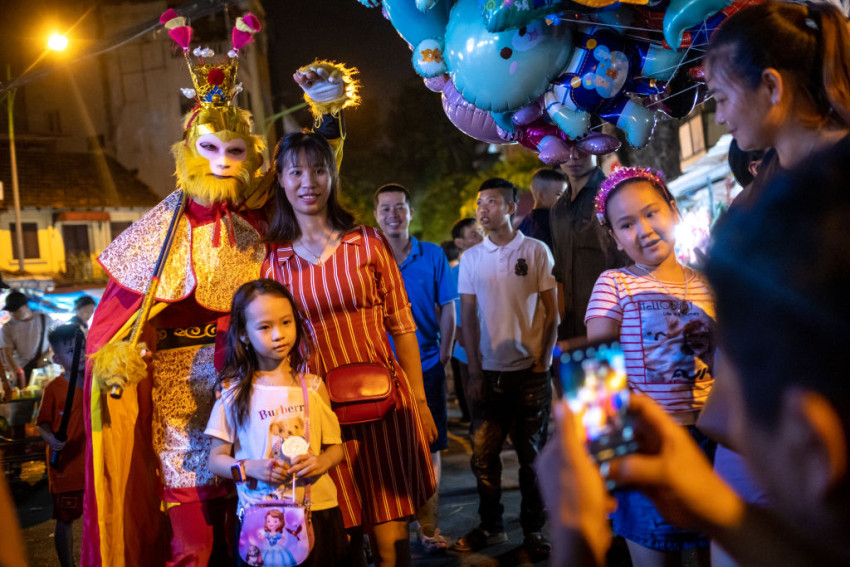
Activities such as moon gazing and hanging lanterns, are popular in some Southeast Asian and East Asian countries - as is the symbol of the rabbit on the moon. However, there are also many different local traditions in each country, according to Time.
China
The legend of Chang'e going to the moon has long been associated with the Mid-Autumn Festival in China.
The story goes that, in ancient times, the earth had 10 suns that burned the whole world. A famous archer named Hou Yi drew his bow and shot down nine suns, saving humanity. Because of his heroic actions, the gods gave him the elixir of immortality, which he entrusted to his wife Hang Nga to preserve. However, one of his followers, Pang Mong, tried to steal the pill while Hou Yi was hunting - so the wife swallowed it to avoid falling into Pang Mong's hands. She became immortal and flew to the moon, where she has lived ever since. Besides Chang'e, the moon also has another resident: Jade Rabbit.
According to Chinese tradition, the full moon symbolizes family reunion, so the Mid-Autumn Festival is a festival celebrated at home. People admire the moon and eat mooncakes filled with a variety of fillings, from traditional salted egg yolks and lotus paste to modern versions filled with cream, fruit and custard.
Other dishes eaten during the festival include taro (as its name in many Chinese dialects is a homonym for "luck comes") and hairy crab, a seasonal delicacy.
Lanterns play an important role in the festival. Today, the old candle-lit paper lanterns are rarely seen. Most children carry battery-operated models. Single-use glow sticks are also popular - leading environmentalists to call for restrictions on their use.
Some regions have specific Mid-Autumn Festival customs. In East China's Zhejiang province, the tides of the Qiantang River attract many tourists. In Hunan province, Dong ethnic women have a custom of stealing vegetables because according to legend, the moon goddess will rain "sweet dew" on them and whoever eats the vegetables will be healthy and happy.
Korea
Koreans celebrate Chuseok, also known as hangawi, during the mid-autumn festival. It is one of the country's biggest and most important holidays, along with Seollal, or Lunar New Year.
Many people return to their hometowns for family reunions and to hold memorial ceremonies, called charye, for their ancestors. The day before and the day after are also holidays in Korea, giving people time to go home.
At festive gatherings, Koreans eat songpyeon, a semicircular rice cake with a sweet filling, as well as seasonal fruits and vegetables such as persimmons and chestnuts. They also enjoy many forms of entertainment, including ganggangsullae, a traditional circle dance. And of course, at night, people go out to admire the full moon, where they search for the moon rabbit, or daltokki. This creature is said to be visible on the lunar surface…
Japan
The Japanese celebrate Tsukimi, which means "watching the moon". Like Koreans, people are always on the lookout for the moon rabbit, called tsuki no usagi in Japanese, as the animal performs the festive task of making rice cakes (mochi).
The festival is said to date back to Japan's Nara period (710 - 794). In the following Heian period (794 - 1185), Tsukimi was very popular among the nobility. Moon viewing parties, often held on boats, include drinking wine, listening to music, and writing poetry. By the Edo period (1603 - 1868), this tradition was widely loved by the public.
Traditionally, tsukimi is marked by decorating the house with pampas grass, symbolizing a bountiful harvest. Festival snacks include tsukimi-dango, round dumplings that symbolize health and happiness, and seasonal products such as chestnuts and pumpkins. Eggs are also consumed because their oval white color is reminiscent of the full moon. Even fast food brands are getting in on the action, adding eggs to burgers.
Vietnam
Vietnamese people also call the Mid-Autumn Festival the Children's Festival.
A popular story related to this festival is about a woodcutter named Uncle Cuoi, who followed a magical banyan tree to the moon. Vietnamese people say that Uncle Cuoi can be seen under the banyan tree during the full moon. During the festival, children holding lanterns - believed to help guide Cuoi back to earth - flood the streets and watch the lion dance.
Families celebrate the Mid-Autumn Festival by displaying cakes and fruit trays, symbolizing filial piety, in front of the ancestral altar in the house. Mooncakes are also the main dish in Vietnam on this occasion and there are two types: baked cakes and sticky rice cakes.




